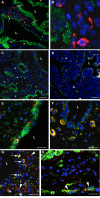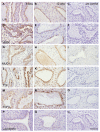Endometrial glands as a source of nutrients, growth factors and cytokines during the first trimester of human pregnancy: a morphological and immunohistochemical study
- PMID: 15265238
- PMCID: PMC493283
- DOI: 10.1186/1477-7827-2-58
Endometrial glands as a source of nutrients, growth factors and cytokines during the first trimester of human pregnancy: a morphological and immunohistochemical study
Abstract
Background: The maternal circulation to the human placenta is not fully established until 10-12 weeks of pregnancy. During the first trimester the intervillous space is filled by a clear fluid, in part derived from secretions from the endometrial glands via openings in the basal plate. The aim was to determine the activity of the glands throughout the first trimester, and to identify components of the secretions.
Methods: Samples of human decidua basalis from 5-14 weeks gestational age were examined by transmission electron microscopy and immunohistochemically. An archival collection of placenta-in-situ samples was also reviewed.
Results: The thickness of the endometrium beneath the implantation site reduced from approximately 5 mm at 6 weeks to 1 mm at 14 weeks of gestation. The glandular epithelium also transformed from tall columnar cells, packed with secretory organelles, to a low cuboidal layer over this period. The lumens of the glands were always filled with precipitated secretions, and communications with the intervillous space could be traced until at least 10 weeks. The glandular epithelium reacted strongly for leukaemia inhibitory factor, vascular endothelial growth factor, epidermal growth factor, transforming growth factor beta, alpha tocopherol transfer protein, MUC-1 and glycodelin, and weakly for lactoferrin. As gestation advanced uterine natural killer cells became closely approximated to the basal surface of the epithelium. These cells were also immunopositive for epidermal growth factor.
Conclusions: Morphologically the endometrial glands are best developed and most active during early human pregnancy. The glands gradually regress over the first trimester, but still communicate with the intervillous space until at least 10 weeks. Hence, they could provide an important source of nutrients, growth factors and cytokines for the feto-placental unit. The endometrium may therefore play a greater role in regulating placental growth and differentiation post-implantation than previously appreciated.
Figures










References
-
- Hustin J, Schaaps JP. Echographic and anatomic studies of the maternotrophoblastic border during the first trimester of pregnancy. Am J Obstet Gynecol. 1987;157:162–168. - PubMed
-
- Jaffe R, Jauniaux E, Hustin J. Maternal circulation in the first-trimester human placenta-Myth or reality? Am J Obstet Gynecol. 1997;176:695–705. - PubMed
-
- Amoroso EC. Placentation. In: Parkes AS, editor. In Marshall's Physiology of Reproduction. 3. Vol. 2. London: Longmans Green and Co; 1952. pp. 127–311.
Publication types
MeSH terms
Substances
Grants and funding
LinkOut - more resources
Full Text Sources
Research Materials
Miscellaneous

